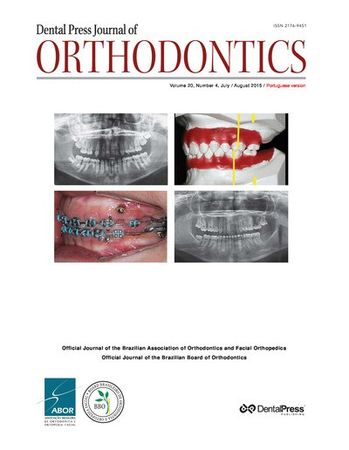Editorial Board
Autores:
messages.RevistaAutores: Corpo Editorial,
LEIA MAIS
Third molars: To extract or not to extract?
Third molar extraction is one of the most frequent procedures in oral surgery. Ten million teeth are extracted from approximately five million individuals every year in the United States.1 The reported reasons for third molar removal include the risk of impaction associated with caries,...
Autores: David Normando,
messages.RevistaAutores: editorial,
LEIA MAIS
THE RISK OF ROOT RESORPTION IS THE SAME IN BANDED AND NON-BANDED TEETH WHEN RAPID MAXILLARY EXPANSION IS CARRIED OUT
Rapid maxillary expansion is one of the most highly respected procedures in contemporary Orthodontics. The potential to orthopedically expand the maxilla favored correction of several occlusal changes. Since rapid expansion was first introduced as an orthodontic procedure, a number of appliances...
Autores: Matheus Melo Pithon,
messages.RevistaAutores:
LEIA MAIS
What is the level of evidence of what you are reading?
Clinicians are typically not trained to evaluate scientific papers. As such, they often struggle trying to determine the level of evidence provided in the papers they read. Lack of training leads the reader to the fallacy of argumentum ad verecundiam when evaluating an article based on the...
Autores: Renato Parsekian Martins, Peter H. Buschang,
messages.RevistaAutores:
LEIA MAIS
An interview with Alvaro Alfredo Figueroa
Alvaro Alfredo Figueroa grew up in Guatemala City, Guatemala, the son of a physician. He was always intrigued by the healthcare field and made it his life and livelihood when he attended dental school at the University of San Carlos in Guatemala. Shortly after graduation, he spread his wings and...
Autores: Eduardo Franzotti Sant’anna, Mônica Tirre De Souza Araújo, Geórgia Wain Thi Lau, Lúcio Henrique E. G. Maia,
messages.RevistaAutores: entrevista,
LEIA MAIS
Color stability of ceramic brackets immersed in potentially staining solutions
Objective: To assess the color stability of five types of ceramic brackets after immersion in potentially staining solutions. Methods: Ninety brackets were divided into 5 groups (n = 18) according to brackets commercial brands and the solutions in which they were immersed (coffee, red wine, coke...
Autores: Matheus Melo Pithon, Dauro Douglas Oliveira, Rodrigo Villamarim Soares, Bruna Coser Guignone, Ludimila Karsbergen Silva, Emilio Akaki, Marcelo Coelho Goiato,
messages.RevistaAutores: Orthodontic brackets, Optical properties, Color instability,
LEIA MAIS
Guidelines proposal for clinical recognition of mouth breathing children
Introduction: Mouth breathing (MB) is an etiological factor for sleep-disordered breathing (SDB) during childhood. The habit of breathing through the mouth may be perpetuated even after airway clearance. Both habit and obstruction may cause facial muscle imbalance and craniofacial changes....
Autores: Maria Christina Thomé Pacheco, Licia Pacheco Teixeira, Nathalia Silveira Finck, Maria Teresa Martins De Araújo, Camila Ferreira Casagrande,
messages.RevistaAutores: Mouth breathing, Craniofacial abnormalities, Airway obstruction,
LEIA MAIS
Evaluation of stiffness and plastic deformation of active ceramic self-ligating bracket clips after repetitive opening and closure movements
Objective: The aim of this study was to assess whether repetitive opening and closure of self-ligating bracket clips can cause plastic deformation of the clip. Methods: Three types of active/interactive ceramic self-ligating brackets (n = 20) were tested: In-Ovation C, Quicklear and WOW. A...
Autores: Hideo Suzuki, Grace Kelly Martins Carneiro, Juliano Alves Roque, Aguinaldo Silva Garcez Segundo,
messages.RevistaAutores: fatigue, Orthodontic brackets, Biomechanics, Laboratory automation,
LEIA MAIS
Four chemical methods of porcelain conditioning and their influence over bond strength and surface integrity
Objective: To assess four different chemical surface conditioning methods for ceramic material before bracket bonding, and their impact on shear bond strength and surface integrity at debonding. Methods: Four experimental groups (n = 13) were set up according to the ceramic conditioning method:...
Autores: Lincoln Issamu Nojima, Mariana Marquezan, João Paulo Fragomeni Stella, Andrea Becker Oliveira,
messages.RevistaAutores: orthodontics, Orthodontic brackets, ceramics,
LEIA MAIS
Evaluation of an alternative technique to optimize direct bonding of orthodontic brackets to temporary crowns
Objective: To compare shear bond strength of different direct bonding techniques of orthodontic brackets to acrylic resin surfaces. Methods: The sample comprised 64 discs of chemically activated acrylic resin (CAAR) randomly divided into four groups: discs in group 1 were bonded by means of...
Autores: Júlio De Araújo Gurgel, Fausto Silva Bramante, Célia Regina Maio Pinzan-Vercelino, Francilena Maria Campos Santos Dias, Rudys Rodolfo De Jesus Tavares, Melissa Nogueira Proença Fialho,
messages.RevistaAutores: Orthodontic brackets, Shear bond strength, Temporary dental restoration, Dental bonding,
LEIA MAIS
Evaluation of facial morphology and sagittal relationship between dental arches in primary and mixed dentition
Objective: To assess facial morphology (Pattern) and sagittal relationship between dental arches (Class), and establish a potential association between them and the variables sex, age and ethnicity, among schoolchildren aged between 4 and 9 years old (mean age of 6.7 years) in primary and mixed...
Autores: Silvia Amelia Scudeler Vedovello, Heloísa Cristina Valdrighi, Aline Traldi, Luciane Zanin De Souza,
messages.RevistaAutores: Dental occlusion, Primary dentition, Epidemiology,
LEIA MAIS
Craniofacial skeletal pattern: is it really correlated with the degree of adenoid obstruction?
Objective: The aim of this study was to compare the cephalometric pattern of children with and without adenoid obstruction. Methods: The sample comprised 100 children aged between four and 14 years old, both males and females, subjected to cephalometric examination for sagittal and vertical...
Autores: Murilo Fernando Neuppmann Feres, Shirley Shizue Nagata Pignatari, Tomas Salomão Muniz, Saulo Henrique De Andrade, Maurilo De Mello Lemos,
messages.RevistaAutores: Angle Class II malocclusion, Diagnosis, Mouth breathing,
LEIA MAIS
Effects of cervical headgear appliance: a systematic review
Objective: Although much has been investigated about the effects of cervical headgear, there remains some controversy. Therefore, the objective of this systematic review is to disclose the actual effects of the cervical headgear appliance, based on articles of relevant quality. Methods: A...
Autores: Guilherme Janson, Daniela Cubas Pupulim, José Fernando Castanha Henriques, Fernanda Pinelli Henriques,
messages.RevistaAutores: Orthodontic appliances, Removable orthodontic appliances, Angle Class II malocclusion, Extraoral traction appliances, Orthopedic appliances,
LEIA MAIS
Orthodontic approach to treat complex hypodontia using miniscrews in a growing patient
This article reports orthodontic treatment of a case of hypodontia of five premolars in an 11-year-old female patient with a positive tooth size-arch length discrepancy in both dental arches. The patient had a straight profile with balanced facial growth. Setup manufacture revealed the...
Autores: Renato Barcellos Rédua, Paulo Cesar Barbosa Rédua, Carlos Eduardo De Almeida Ferreira, Adriana De Oliveira Lira Ortega,
messages.RevistaAutores: Anodontia, Orthodontic space closure, Orthodontic anchorage,
LEIA MAIS
Conservative treatment of Angle Class III malocclusion with anterior crossbite
Angle Class III malocclusion is characterized by anteroposterior dental discrepancy which might be associated or not with skeletal changes. Class III molar relationship is associated with vertical or lingually tipped mandibular incisors and a usually concave profile. These characteristics...
Autores: João Hélder Ferreira De Aguiar,
messages.RevistaAutores: Corrective Orthodontics, Angle Class III malocclusion, Crossbite,
LEIA MAIS
Therapeutic approach to Class II, Division 1 malocclusion with maxillary functional orthopedics
Introduction: Interceptive treatment of Class II, Division 1 malocclusion is a challenge orthodontists commonly face due to the different growth patterns they come across and the different treatment strategies they have available. Objective: To report five cases of interceptive orthodontics...
Autores: Orlando Tanaka, Armando Yukio Saga, Ariel Adriano Reyes Pacheco, Aristeu Corrêa de BITTENCOURT NETO,
messages.RevistaAutores: klammt, Interceptive orthodontics, Class II, Activator,
LEIA MAIS



